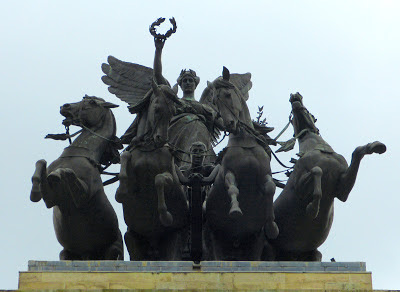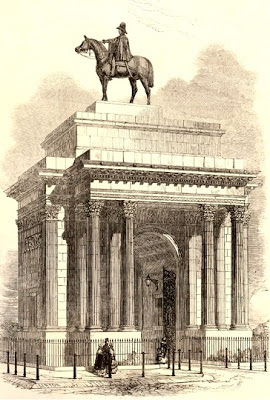 |
| Wellington Arch, Hyde Park Corner, London (2013) |
The Wellington Arch is a victory arch, celebrating the Duke of Wellington’s defeat of Napoleon. It stands in the middle of the Hyde Park Corner roundabout opposite to Apsley House, Wellington’s London residence.
The Green Park arch
The arch was originally planned as a grand gateway to Buckingham Palace. A design by Decimus Burton was approved as part of a scheme to improve the royal parks. The arch could not straddle the road as this would limit the width of the carriageway and cause congestion. So when it was built in 1825-7, the 'Green Park Arch' was placed on one side of the road, providing an entrance into Green Park, whilst a screen of pillars was placed on the opposite side of the road, providing an entrance into Hyde Park.
 |
| Design for the Green Park Arch from Illustrations of the public buildings of London by WH Leeds (1838) |
A sculpture of a quadriga – an ancient four-horsed chariot - was originally planned for the top, but the building works went over budget and so the sculpture was never built.
The controversial equestrian statue of Wellington
During the 1830s, the Wellington Memorial Committee was formed. They wanted a fitting monument to the hero of Waterloo and thought that an equestrian statue of Wellington on top of Green Park Arch, which stood near to the Duke’s home, Apsley House, would be a suitable monument. The committee pushed through its plans and, in 1846, a huge statue of Wellington on his horse, sculpted by Matthew Cotes Wyatt, was placed on the top of the arch. The decision was widely controversial and the size of the statue was ridiculed by the cartoonists of the day as being oversized.
The government insisted that the statue should be taken down, but when Wellington declared that he would resign if they removed it, they backed down.
Constitution Arch
In 1883-5, the statue was taken down so that the arch could be moved to its current position at the top of Constitution Hill to allow the widening of the carriageway. One side of the arch became a park-keeper’s residence whilst the other was used as a police station.
The equestrian statue of Wellington was not replaced and the arch stood empty for many years. The original equestrian statue of Wellington was moved to a new plinth near the Garrison Church in Aldershot.
The quadriga
In 1891, Adrian Jones, a sculptor, exhibited a model of a quadriga named Triumph at the Royal Academy exhibition. It was decided that this would make a fitting sculpture for the top of the arch. The resulting bronze statue of the Angel of Peace descending on the quadriga of war was mounted on the arch in 1911-12.
 |
| The Angel of Peace descending on the quadriga of war on top of the Wellington Arch (2013) |
In the 1960s, further road improvements led to the creation of the Hyde Park Corner roundabout. The Wellington Arch became isolated in the centre of this roundabout.
Today, the Wellington Arch is in the care of English Heritage and it is possible to climb up inside it and obtain views of Apsley House and the surrounding area of London.
Rachel Knowles writes clean/Christian Regency era romance and historical non-fiction. She has been sharing her research on this blog since 2011. Rachel lives in the beautiful Georgian seaside town of Weymouth, Dorset, on the south coast of England, with her husband, Andrew.
Find out more about Rachel's books and sign up for her newsletter here.If you have enjoyed this blog and want to encourage me and help me to keep making my research freely available, please buy me a virtual cup of coffee by clicking the button below.
Sources used include:
Leeds, William Henry, Illustrations of the public buildings of London (1838)
English Heritage webpage on the Wellington Arch
Photographs © RegencyHistory.net




On a visit to London with friends, I didn't know whether to laugh or cry when one of them pointed out the "Napoleon Memorial".
ReplyDeleteOh no! How wrong can you get?!
DeleteWe had the same exclamation at Nelson's Column; getting a little confused, methinks.
ReplyDeleteI am lost for words...
DeleteI have heard it said that many British visitors to the site of the Battle of Waterloo think the statue of the Lion on the ridge is a memorial to the British.
ReplyDeleteI confess I had to look it up to see that it was in fact commemorating where the Prince of Orange fell. I have not been to Waterloo (yet) but my husband is keen on military history and would no doubt have put me right had I dared to suggest it had anything to do with the British!
Delete